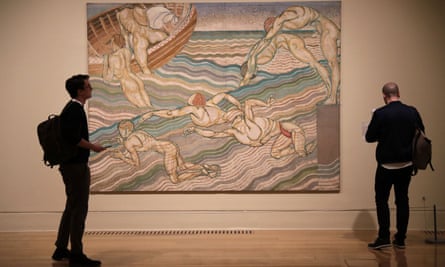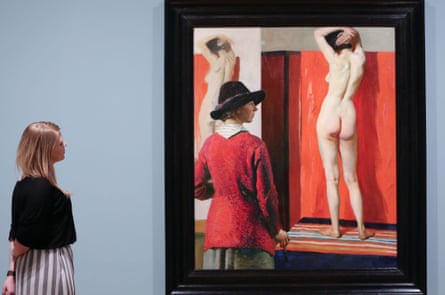A rainbow flag is to be hoisted over Tate Britain as the gallery opens the first major exhibition dedicated to queer British art, from covert images of same-sex desire by Simeon Solomon to the couldn’t care less enjoyment of David Hockney.
The gallery is marking the 50th anniversary of the 1967 Sexual Offences Act, a momentous, transformative moment which decriminalised private homosexual acts between men over 21 in England and Wales.
Works by artists including Francis Bacon, Keith Vaughan, Dora Carrington and Evelyn de Morgan are going on display this week for an exhibition that both celebrates sexuality as well as noting the misery it has sometimes brought.
A case in point is Solomon, a leading member of the Pre-Raphaelite movement, whose life changed in 1873 when he was caught with a man in a public toilet.
“He has a massive fall from grace,” said the show’s curator Clare Barlow. “He goes from being an artist who exhibits at the Royal Academy to being someone who is in and out of workhouses.”

Many of Solomon’s friends, with some honourable exceptions such as Edward Burne-Jones, abandoned him. “There is a huge fear about being associated with him because people might talk,” said Barlow.
The Tate exhibition includes seven Solomon works, from a sensual depiction of a square-jawed Bacchus made before his troubles; to a drawing made many years afterwards of Medusa with a Latin inscription which translates as “the corruption of the best is the worst thing of all”.
“What is wonderful is to be able to put Solomon’s work in this wider context,” said Barlow. “This extraordinary range of different possibilities that artists are exploring.”
Solomon is in a room entitled Coded Desires, containing works that would have been seen very differently by 19th-century eyes. For example, Frederic Leighton’s overtly homo-erotic sculpture of a beautiful young man, The Sluggard, might not have seemed so blatant to the Victorians.

Whether Leighton would have been happy to be exhibited in a show of homosexual art is also open to question. “He is a very intriguing figure,” said Barlow. “There are lots of rumours about him from his own time all the way through to the present, but nothing can be substantiated. His sexuality is a big question mark.”
One of the highlights of the show is the loan from Los Angeles of a full-length portrait of a happy and healthy 27-year-old Oscar Wilde. It was painted by the American artist Robert Goodloe Harper Pennington and presented to Wilde and his wife, Constance, as a wedding present in 1884. It is being shown in the UK for first time.
The 1.85 metre (6ft) painting of a confident Wilde offers a counterpoint to his catastrophic later life when, in April 1895, the Marquess of Queensberry, the father of Wilde’s lover, Lord Alfred Douglas, or Bosie, accused Wilde of “posing as a sodomite”.
Wilde’s decision to sue set in train a sequence of events that led to jail, hard labour, and early death, a story told in the exhibition by placing the door from Wilde’s Reading prison cell next to his portrait.
The exhibition takes 1861 as its starting point, the year that the death penalty for sodomy was abolished; and 1967 as its end point – a decade represented by artworks that were far less inhibited and covert than previous ones.

These include Hockney’s Life Painting for a Diploma, in which he copied the beefcake male model from the Young Physique magazine cover to produce a work that satisfied the life study assessment criteria at the Royal College of Art.
Another arguably less erotic work is a nude drawing of Joe Orton by Patrick Procktor which was commissioned by the Royal Court to be reproduced in a programme. Orton later said: “He drew me lying on the bed ... I kept my socks on because I think they’re sexy.”
The show is accompanied by a catalogue in which the Tate chairman Lord Browne, a former BP chief executive, uses the foreword to give an account of his own experience of remaining “in the closet, hiding my true identity” until 2007.
Browne writes of his pride in the show. “Our ability to bring together a collection of queer British art and to expose our audience to a once taboo topic demonstrates the progress made in the last 50 years. But the fact that this is the first exhibition of its kind shows that society has yet to fully accept LGBTQ+ culture. Until it has, Tate will continue to lead.”










